Transition Sentinel V3
Wheel Sizes:
- S–XXL: 29’’ front and rear (mixed wheel compatible)
- XS: 27.5’’ front and rear
Suspension Travel:
- Frame: 150 mm (160 mm w/ 65 mm stroke shock)
- Fork: 160 mm
Geometry Highlights:
- Sizes offered: XS, S, M, L, XL, XXL
- Headtube angle: 64°
- Reach (size Large): 480 mm
- Chainstay length (size Large): 448 mm (Carbon), 446 mm (Aluminum)
Frame Material: Aluminum and carbon fiber versions available
Price: Complete bikes starting at $3,299 USD (details in Builds section below)
Blister’s Measured Weight (Size Large, Carbon XT build): 32.40 lb / 14.70 kg
Test Locations: Washington, Arizona
Reviewers:
- Zack Henderson: 6’, 165 lbs / 183 cm, 74.8 kg
- David Golay: 6’, 160 lbs / 183 cm, 72.6 kg
Test Duration: 3 months
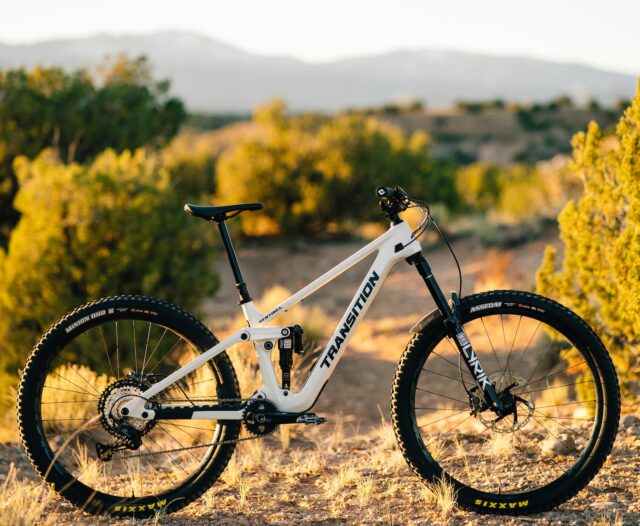
Intro
The release of the 2018 Transition Sentinel was a bit of a seminal moment in mountain bike design. Sure, it had its flaws (which I’m familiar with — I owned one), but it also was one of the first mainstream examples of combining a truly slack head tube angle, shorter fork offset, long reach, and steep seat tube angle. Despite having just 140 mm of inadequately progressive rear suspension travel, it felt like I could get away with murder on that bike since it was so stable at speed and in steep terrain compared to just about every other Trail bike out there at the time. Transition called that concept Speed Balanced Geometry (or SBG), and while the acronym has become less relevant given the near-ubiquitous adoption of the underlying geometry concept across the bike industry, the influence and importance of that first Sentinel can’t be ignored.
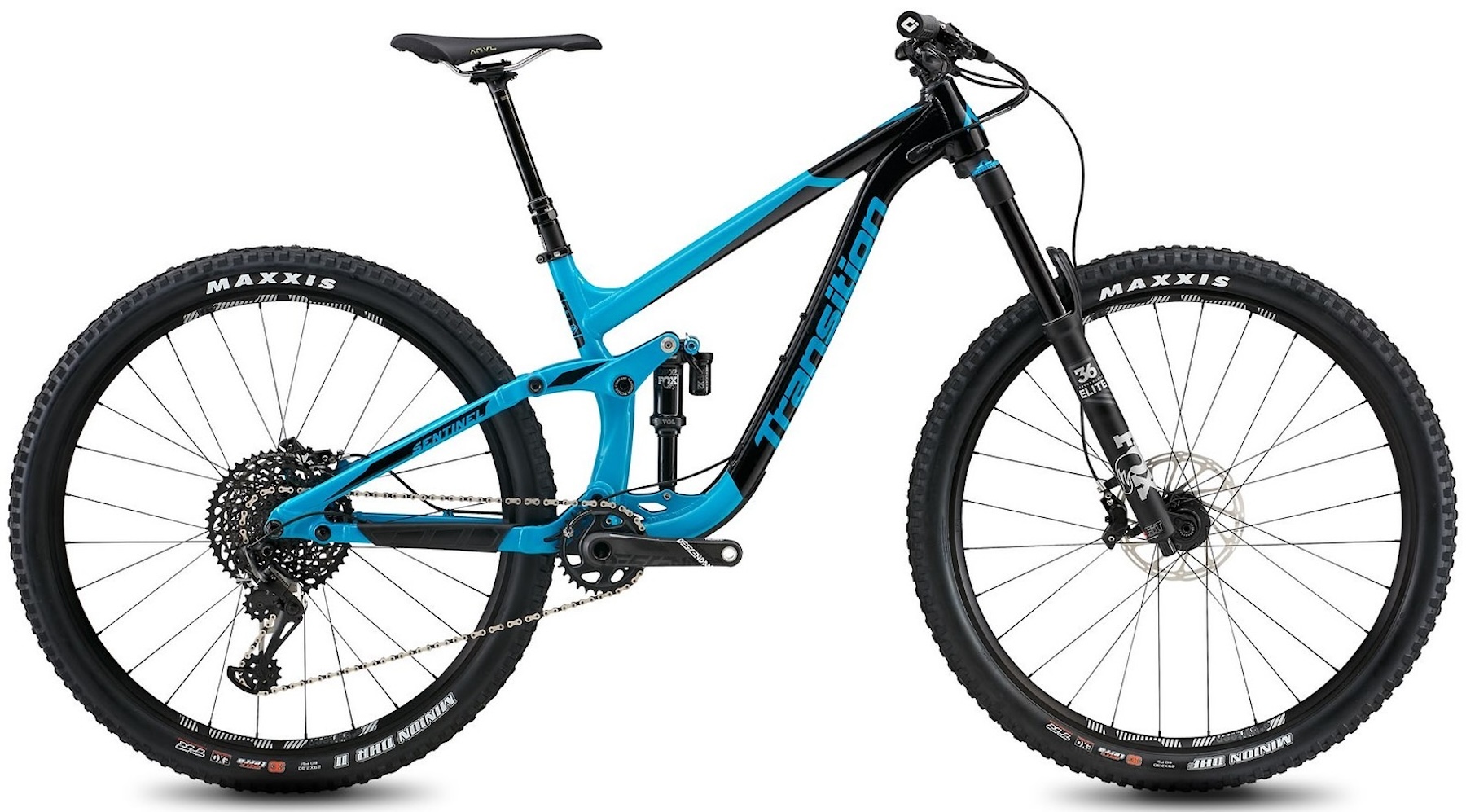
The Sentinel entered its second iteration back in 2021, still positioned at the intersection of Trail and Enduro — and it was Transition’s longest-travel 29er at the time. So it’s been almost 4 years since the last revision, and at long last, it’s here — the third-generation Sentinel. Despite similar intentions to the outgoing bike, the geometry has been revised, in-frame storage and mixed wheel compatibility have been added, and Transition has refined a bunch of the other details, too. Let’s check out what the new Sentinel has to offer.
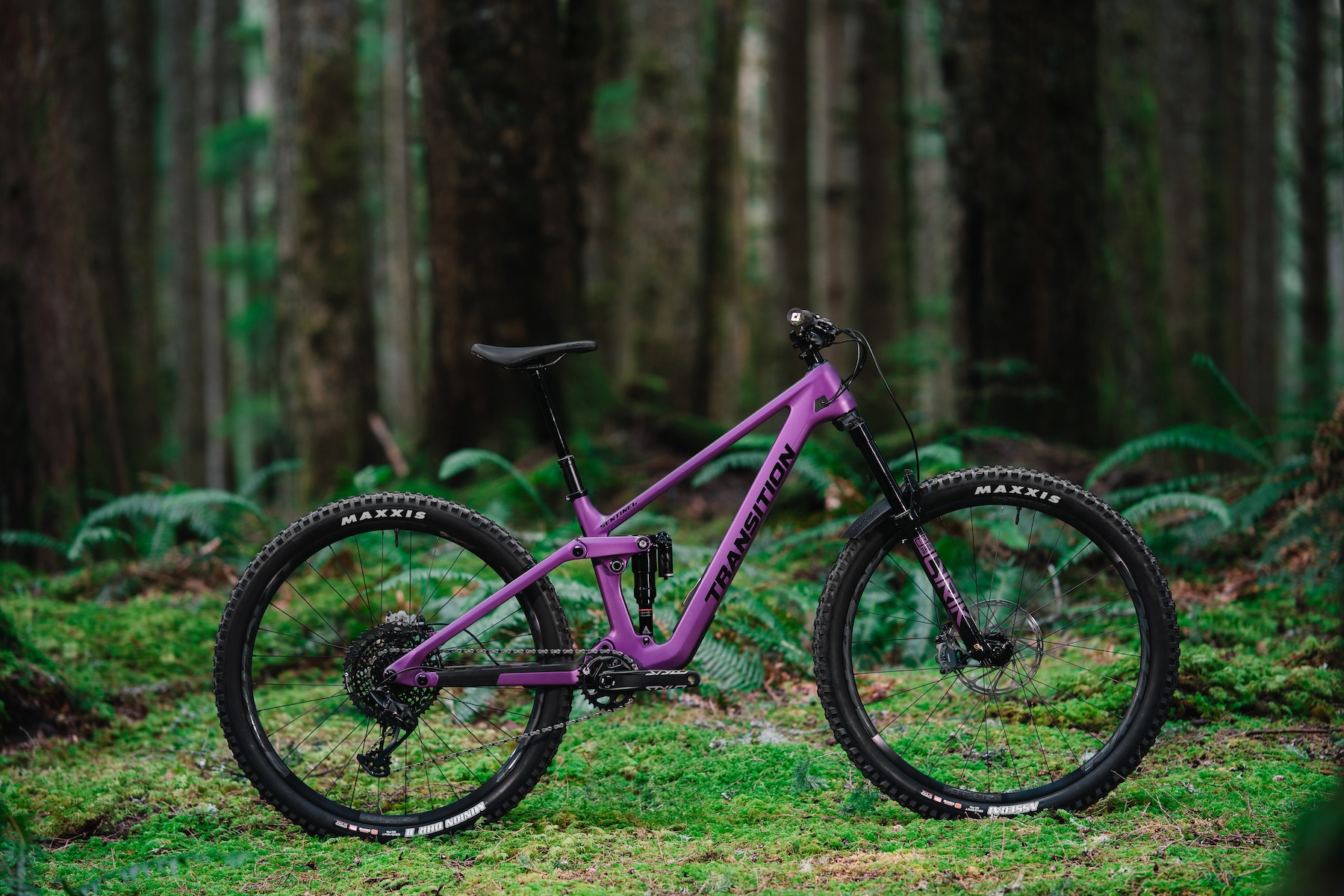
The Frame
Transition has built its full lineup around a very familiar frame aesthetic that is both contemporary in its angular shapes, while still having a rather traditional four-bar suspension layout. The new Sentinel gets some updated industrial design details, but still very much looks like a Transition. It also still comes in both carbon and aluminum, with both frames sharing nearly all of the same features, and now comes in a whopping six sizes, from XS to XXL.
Like the old one, the new Sentinel gets 150 mm of rear travel matched to a 160 mm fork, though Transition says that it can go up to 160 mm of rear travel with a swap to a longer 65 mm stroke shock from the stock 60 mm one. Transition says that they’ve revisited the Sentinel’s suspension kinematics to offer more support earlier in the travel — a welcome change in my experience, as the high starting leverage rate on their past generation of bikes could feel a bit unsupportive in the first third of the travel. Transition has gone with a 25% progression rate, which should play nice with coil shocks — the leverage curve is as follows:
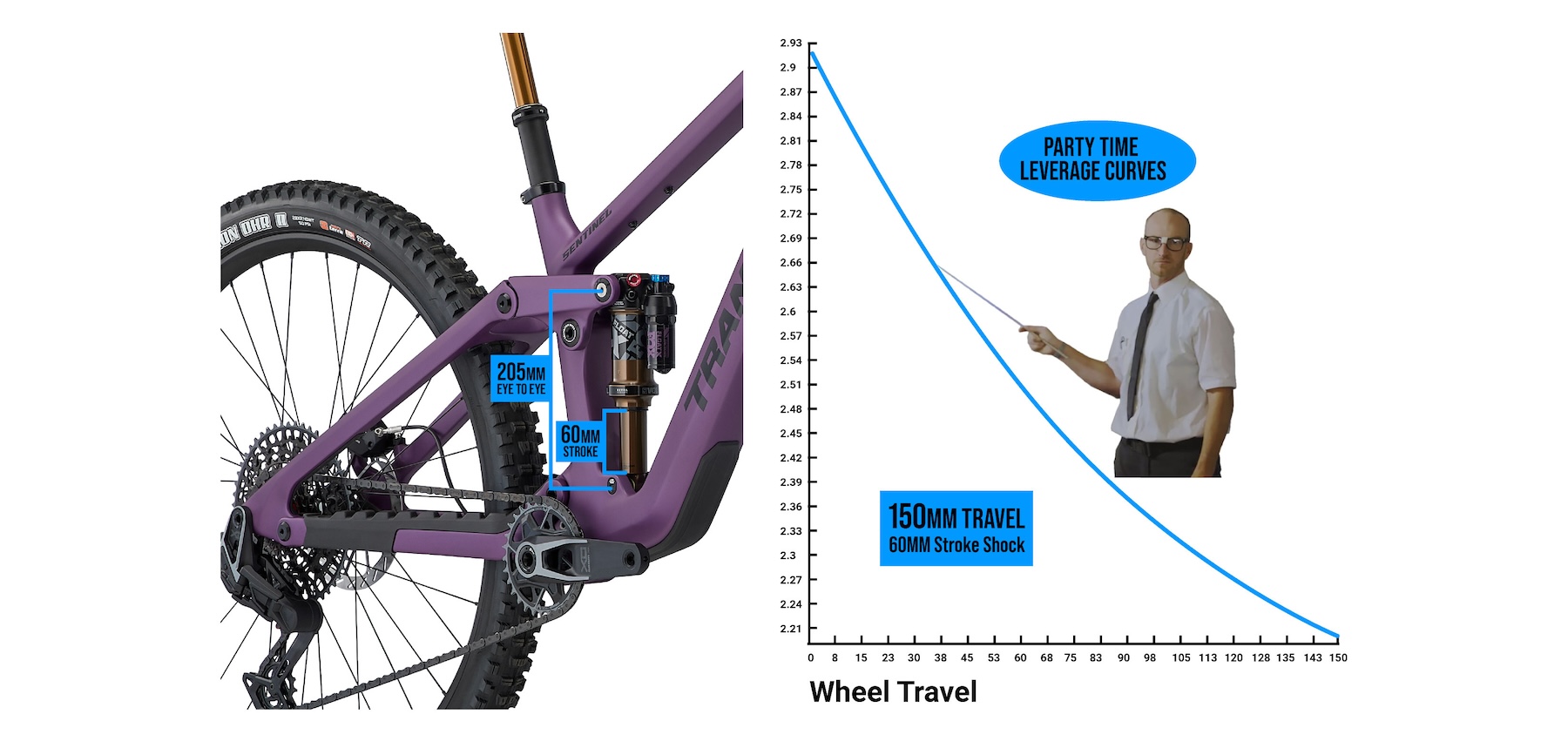
While the outgoing Sentinel was a 29’’ wheeled affair, Transition now includes a flip chip at the lower shock mount to accommodate either full 29’’ wheels or a mixed wheel setup. Small through XL sizes come with 29’’ wheels as stock and can be switched to mixed as an aftermarket option, while the XS is 27.5’’ front and rear only.
The only feature difference between the Sentinel’s carbon and aluminum frames is that in-frame storage is limited to the carbon option. Transition has added their new B.O.O.M. (Burritos or Other Munchies) Box design, which comes with two gear bags for organization, and there is still an accessory mount under the top tube too. Both frame options include a Fidlock base as a water bottle mount option to maximize bottle size in the given amount of space, though you have to buy the bottle separately. You can of course still run a regular old bottle cage too.
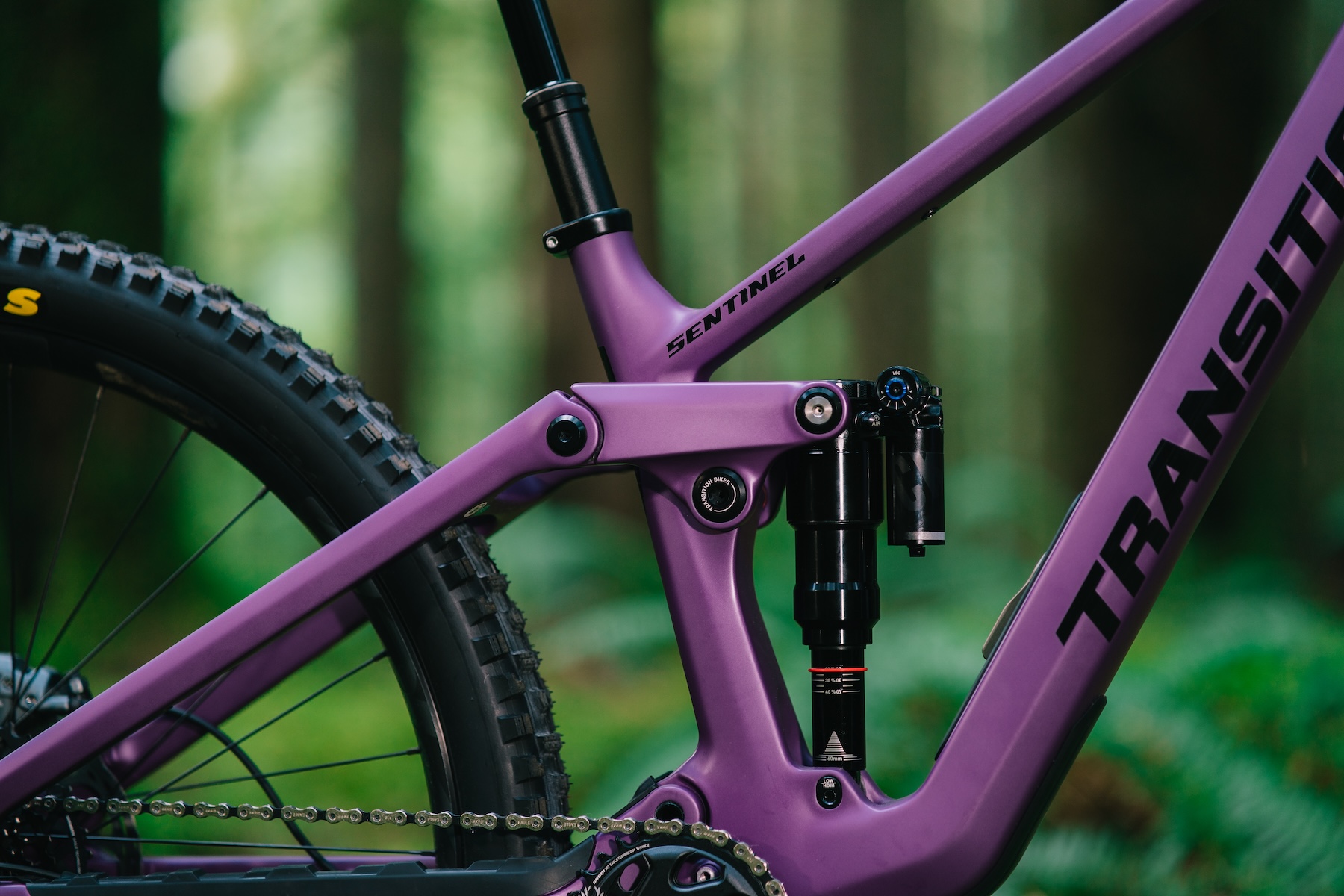
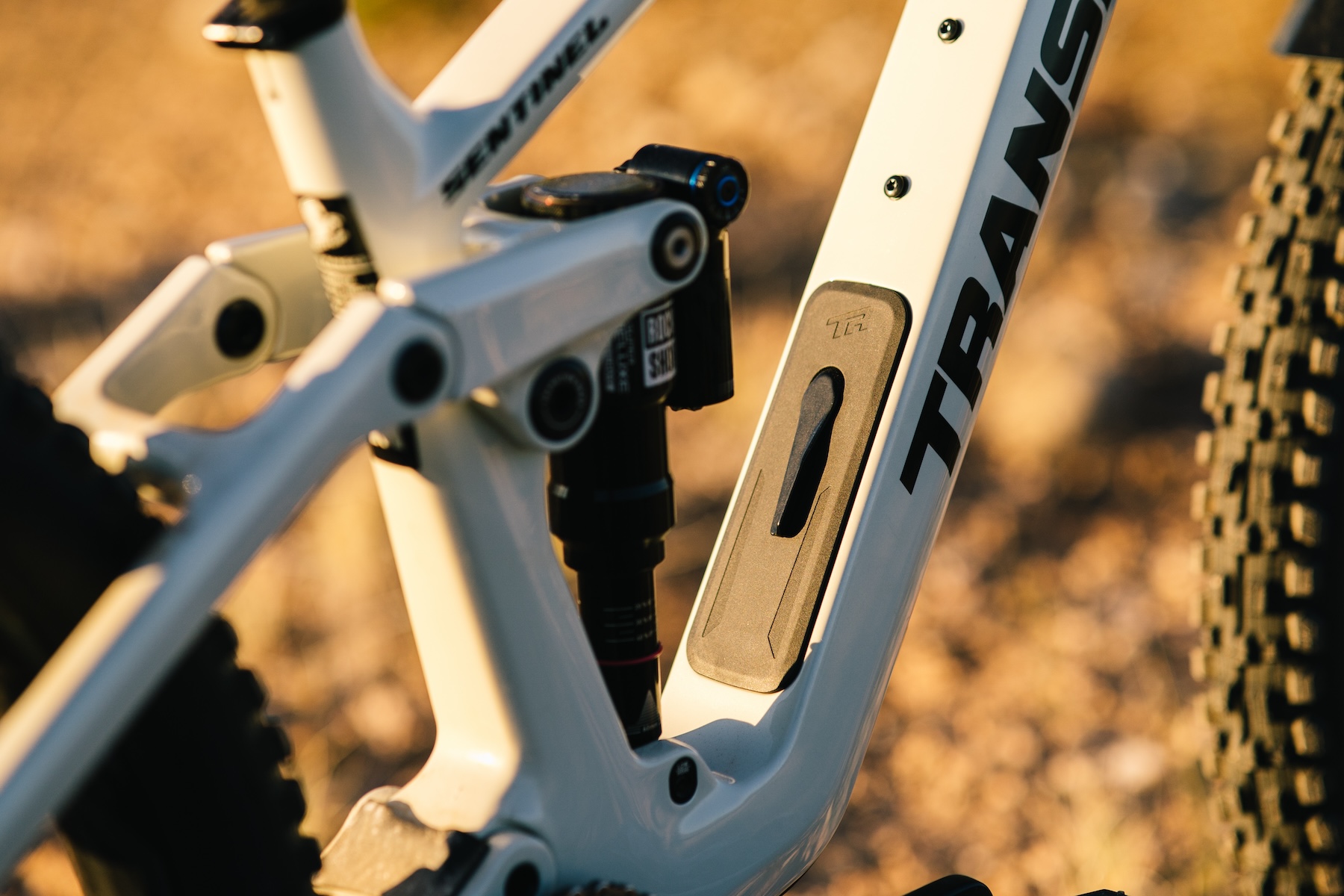
The Sentinel also gets a new, much more substantial chainstay protector, as well as revised cable routing via new bolt-on covers at the head tube, which more securely clamp cables to prevent rattling. Transition has also revised the lower shock mount area on the carbon frame to prevent water and grit from forming a little pond around the shock eyelet, which I affectionately call the “swimming pool” on my Repeater.
Apart from the B.O.O.M. Box being a carbon-only feature, there’s also a significant weight difference between the carbon and aluminum frames. A Medium carbon Sentinel frame rings in at a claimed weight 7.41 lbs / 3.36 kg, while the Medium aluminum frame is quite hefty at 9.91 lbs / 4.5 kg. The cost difference is $1,200 USD between the two frames, but with the Alloy Deore build ringing in at 36.4 lbs with EXO casing tires in a size Medium, such a substantial weight difference between the two frame materials is worthy of consideration.
Fit & Geometry
The new Sentinel has gotten several revisions when it comes to geometry, and they’re all promising changes in my view. In the stock 29’’ configuration with the flip chip in Low (or the stock 27.5’’ wheel configuration in the case of the XS), Transition has actually made the Sentinel a touch steeper at the head tube — now measuring at 64° rather than the prior version’s 63.6°. That’s not a huge change, to be fair, but I think the 64° suits the Sentinel’s more all-around intentions a bit better. Using a Large as the reference point, reach has increased slightly to 480 mm, the stack is 633 mm, and the bottom bracket drop has reduced slightly to 25 mm from the previous 29 mm.
Swapping to a mixed wheel setup via the High flip chip position makes things a bit slacker. The head tube angle shifts to 63.6°, and a size Large sees the reach tighten up slightly to 476 mm, with the stack increasing to 636 mm.
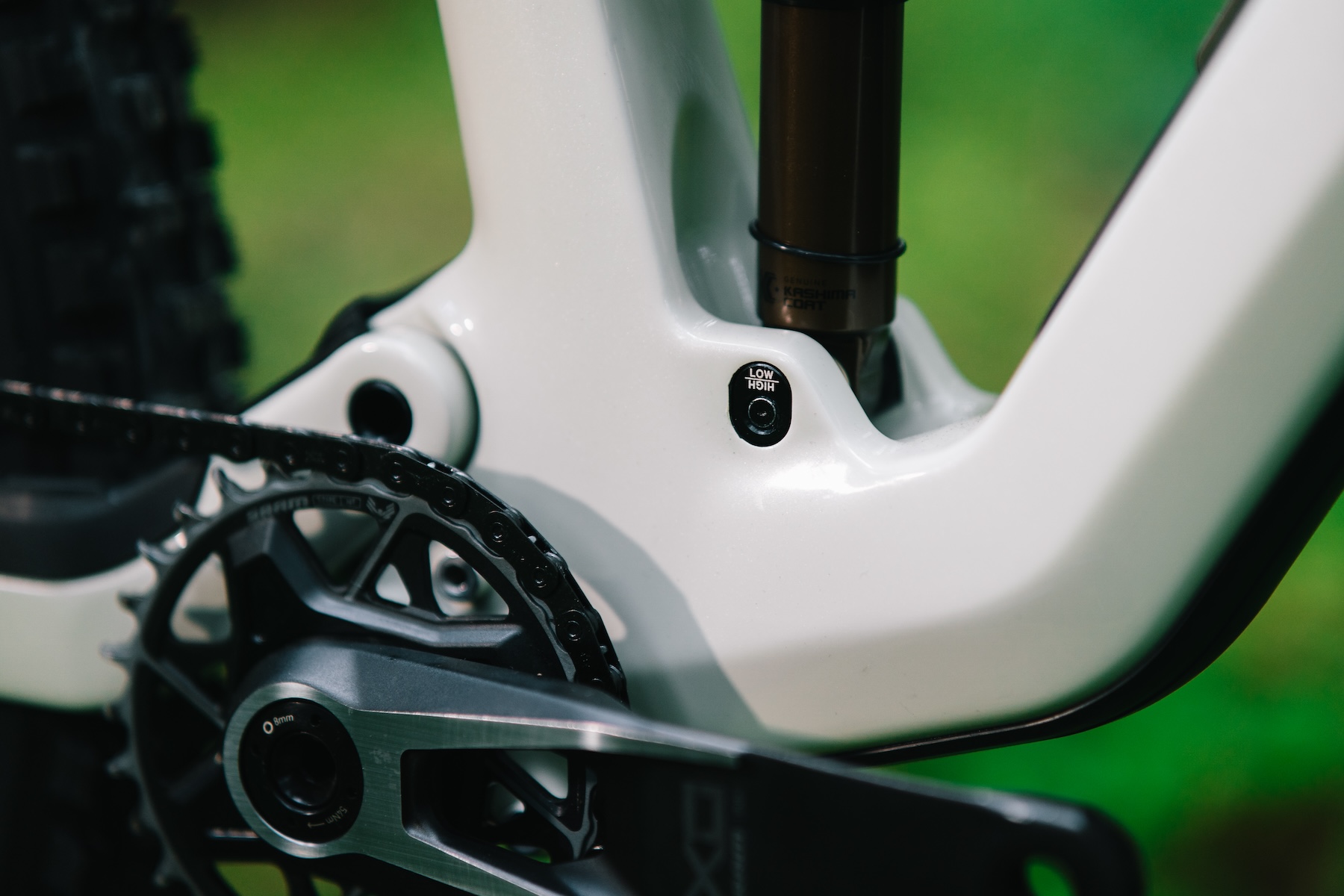
One interesting detail is the difference in geometry between the Sentinel’s alloy and carbon frames. While I imagine this has to do with the aluminum frame requiring some slightly different tubing placements, there are some notable differences. In the stock 29’’ configuration, the carbon model has a substantially steeper seat tube angle at 78.3° in a size Large, compared to 77.3° with the aluminum version. The carbon frame’s effective top tube length is quite a bit shorter than the aluminum one as a result, at 605 mm in Large compared to the metal bike’s 614 mm.
With the new Sentinel, Transition also offers size-differentiated chainstays, but they are again a bit different by frame material. In the stock 29’’ configuration, a Large carbon frame has 448 mm chainstays, while an aluminum one is 2 mm shorter at 446 mm. Those 448 mm (carbon) and 446 mm (aluminum) chainstays persist on sizes Large through XXL, while the Small and Medium bikes get 442 mm chainstays for both frame materials. The XS has the shortest stays at 436 mm given its diminutive size and 27.5’’ rear wheel.
As a final note, while Transition says you can run either geometry setting at a given wheel size, I’d suspect that things would get a bit too tall and steep with 29’’ wheels in High mode, while mixed wheels in Low mode would be very low and slack.
Full geometry is as follows for all sizes, frame materials, and wheel size options:
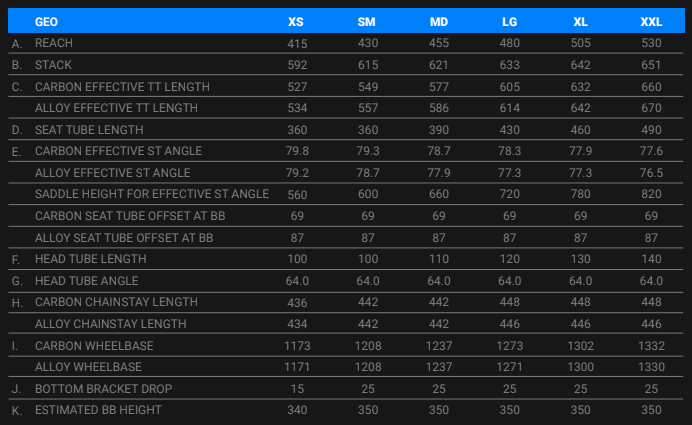
The Builds
Transition is offering two aluminum builds and three carbon builds for the Sentinel, along with frame-only options for both materials. Builds are nearly identical across the two frame materials until you get to the top-shelf carbon build.
The base model is the Deore build, which comes with a full Deore drivetrain and four-piston brakes from Shimano. The alloy model gets a RockShox Super Deluxe Base rear shock and a Psylo Gold RC fork, while the carbon build steps up slightly to a Super Deluxe Select rear shock and Lyrik Select fork. The next step is the XT build, which unsurprisingly gets a full Shimano XT drivetrain and four-piston brakes. Suspension is again a RockShox Super Deluxe rear shock and Lyrik fork, and again differentiated slightly by frame material: the aluminum option gets the Select+ models while the pricier carbon build jumps to RockShox’s range-topping Ultimate models.
The lone build with Fox suspension is the XO AXS build, which is offered for the carbon frame only. A Fox 36 Grip X2 Factory fork is matched to a Float X Factory rear shock, with XO Transmission handling shifting and SRAM’s powerful Maven Silver brakes handling stopping duties.
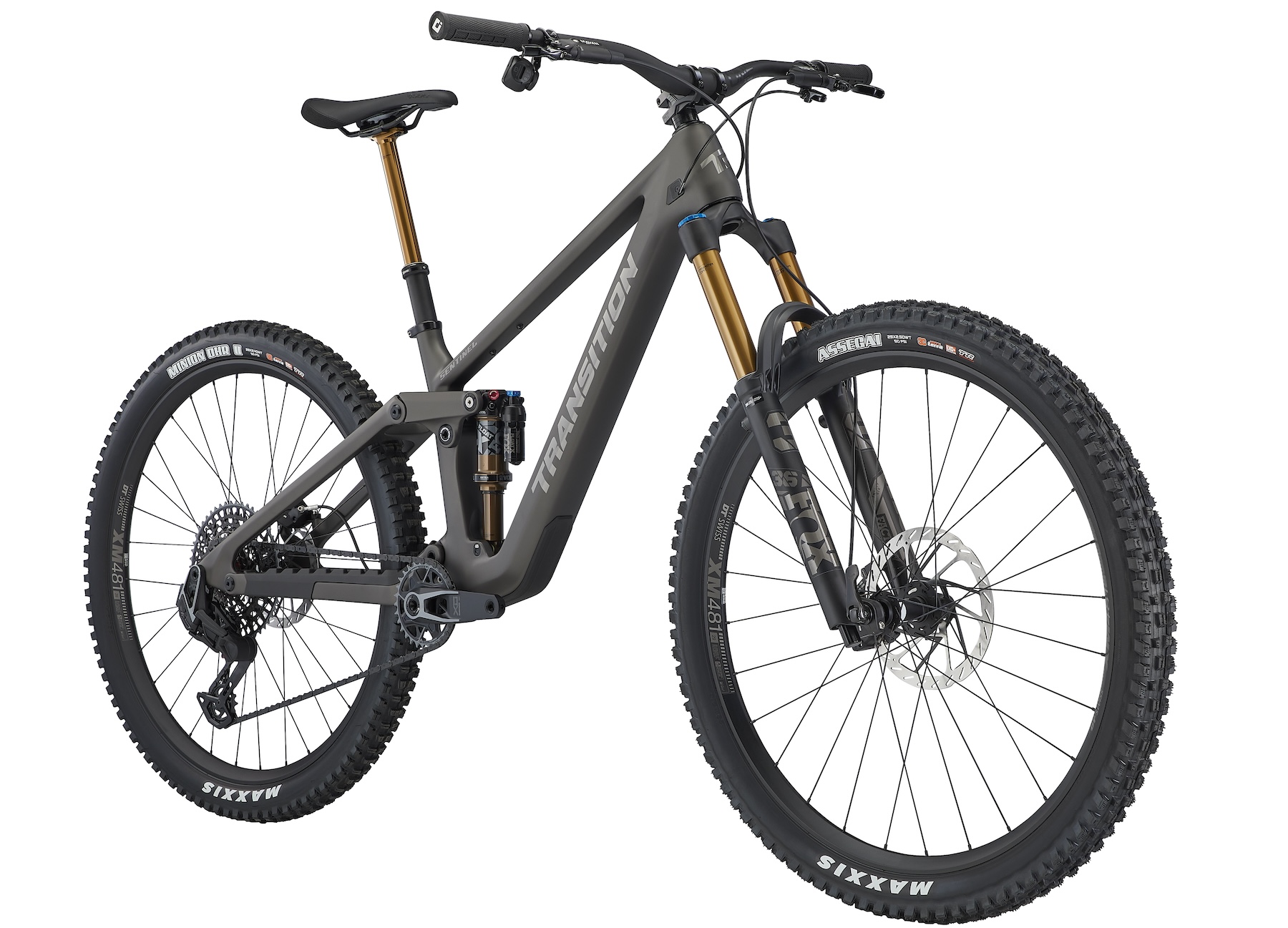
Dropper post lengths are generous across the board, which is great to see — the XS starts at 120 / 125 mm depending on the build, and the XL and XXL sizes reach as high as 230 mm / 240 mm.
Interestingly, each model sticks with aluminum wheels, there are no fancy electronic suspension upgrades on offer, and there’s only one build that comes with electronic shifting. While the range-topping XO AXS build sure isn’t what I would call affordable at $7,899 USD, Transition seems to have kept prices in check while offering balanced and well-chosen builds, with the aluminum XT build being a particular standout on the value front.
Full build details are as follows:
- Drivetrain: Shimano Deore
- Brakes: Shimano Deore M6120 (203 mm rotors)
- Fork: RockShox Psylo Gold RC (160 mm)
- Shock: RockShox Super Deluxe Base
- Wheels: WTB ST i30 rims, Novatech hubs
- Dropper post: SDG Tellis (XS: 125 mm, S: 150 mm, M: 170 mm, L: 200 mm, XL/XXL: 230 mm)
- Drivetrain: Shimano XT
- Brakes: Shimano XT M8120 (203 mm rotors)
- Fork: RockShox Lyrik Select+ (160 mm)
- Shock: RockShox Super Deluxe Select+
- Wheels: DT Swiss M 1900 Spline 30
- Dropper post: OneUp V3 (XS: 120 mm, S: 150 mm, M: 190 mm, L: 210 mm, XL/XXL: 240 mm)
- Drivetrain: Shimano Deore
- Brakes: Shimano Deore M6120 (203 mm rotors)
- Fork: RockShox Lyrik Select (160 mm)
- Shock: RockShox Super Deluxe Select
- Wheels: WTB ST i30 rims, Novatech hubs
- Dropper post: SDG Tellis (XS: 125 mm, S: 150 mm, M: 170 mm, L: 200 mm, XL/XXL: 230 mm)
- Drivetrain: Shimano XT
- Brakes: Shimano XT M8120 (203 mm rotors)
- Fork: RockShox Lyrik Ultimate (160 mm)
- Shock: RockShox Super Deluxe Ultimate
- Wheels: DT Swiss M 1900 Spline 30
- Dropper post: OneUp V3 (XS: 120 mm, S: 150 mm, M: 190 mm, L: 210 mm, XL/XXL: 240 mm)
- Drivetrain: SRAM XO Transmission
- Brakes: SRAM Maven Silver (200 mm front / 180 mm rear rotors)
- Fork: Fox 36 Grip X2 Factory (160 mm)
- Shock: Fox Float X Factory
- Wheels: DT Swiss XM 481 rims, DT Swiss 350 DEG hubs
- Dropper post: Fox Transfer Factory (XS: 120 mm, S: 150 mm, M: 180 mm, L: 210 mm, XL/XXL: 240 mm)
Frame-only options are available in both carbon and aluminum, both with a RockShox Super Deluxe Ultimate rear shock. The more affordable aluminum option costs $2,199 USD, and the carbon one costs $3,399 USD.
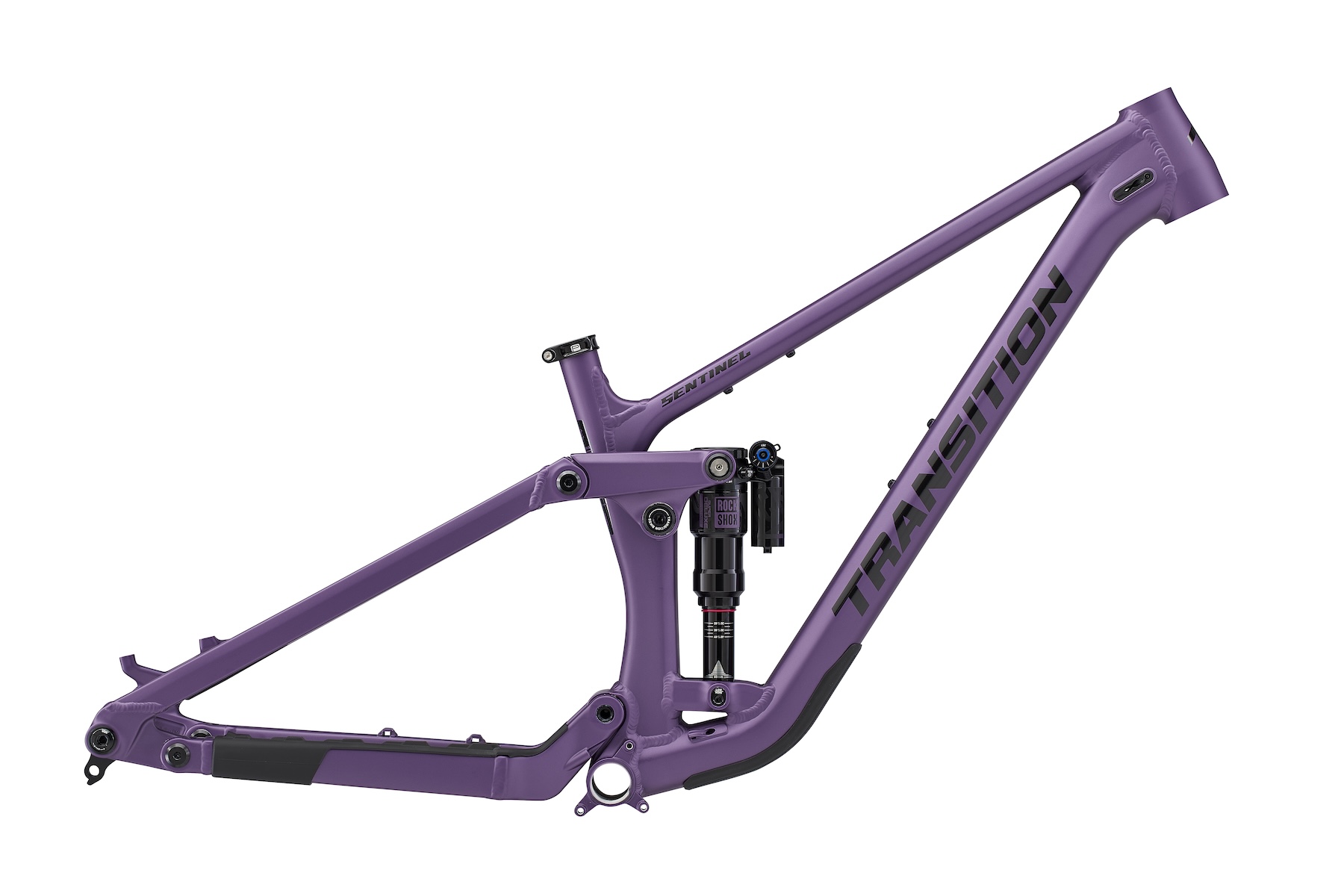
FULL REVIEW
The original Transition Sentinel was a major milestone in modern Trail bike development. It sure wasn’t for everyone, but it marked a pivotal moment in bike evolution toward longer, lower, and slacker designs. Particularly for a 140 mm rear travel bike, the Sentinel’s geometry concept upped the ante as far as how poised Trail and Enduro bikes could feel in serious terrain.
Now in its third generation, and despite its genre-defining origins, the Sentinel now sits as a modern rendition of an all-rounder Trail bike. With 150 mm of rear travel, it sits in a travel bracket that makes sense for a lot of riders in different locales. But how does it perform? We spent a few months finding out.

Fit & Sizing
Zack Henderson (6’, 165 lbs / 183 cm, 74.8 kg): Looking at the Sentinel’s geometry figures, nothing really catches the eye — and I mean that in a good way. The combination of the 480 mm reach and 64° headtube angle (in 29’’ mode) feels familiar from a handling perspective, though the 605 mm effective top tube length is definitely on the shorter side of my preference. The steep 78.3° effective seat tube angle is largely to blame there, and I ended up sliding the saddle back fairly far to try to lengthen that seated position. The reach does shrink slightly in mixed wheel mode to 476 mm.
While I do also prefer a touch higher than the 29’’ setup’s 633 mm stack (636 mm in mixed wheel configuration), I ended up trying to keep the stem as low as possible on the steerer tube (running minimal spacers between the headset and stem) and instead opting for a 40 mm rise handlebar. More spacers under the stem inherently reduce both stack and effective top tube length, and by instead relying on the handlebar to get the extra height I wanted, I was able to again eke out a few more millimeters of room in the cockpit.
Perhaps the only measurement that could raise some eyebrows is the fairly long 448 mm chainstay measurement in 29’’ mode. XS through Medium sizes are shorter at 442 mm, while the Large is the first to jump to the longer stays used up through the XXL. I happen to be quite a fan of longer chainstays in most applications, with many of my favorite bikes sitting in the 445 – 455 mm window. Swapping into mixed wheel mode does lop a couple of millimeters off of that measurement, but especially for a Trail bike, the Sentinel’s chainstays are on the longer side of average. That pays some dividends in calming the handling at higher speeds, and helps make the mixed wheel handling feel notably good — but more on that in a minute.
David Golay (6’, 160 lbs / 183 cm, 72.6 kg): I also got along well with the fit of the Large Sentinel and didn’t have any real challenges getting things dialed in. Like Zack, I wouldn’t mind if the stack height was a little higher, and I’m closer to wanting to size up to the XL than I am interested in dropping down to the Medium, but I’m confident that the Large is the right size for me overall — just as Transition’s sizing chart suggests.

I was able to get comfortable enough with the stock 30 mm rise bar, but also experimented with a 40 mm rise one for a bit, and found the slightly longer seated cockpit that it produced (mostly by moving the stem lower on the steerer tube, effectively shortening the reach less than a stem higher on the steerer would) was a little more comfortable, particularly on steeper climbs.
Whatever slight qualms I might have had about the Large Sentinel feeling borderline short on the way up were quickly dispelled once I started descending on it. It’s still not an especially big-feeling bike for my proportions and preferences, but the Sentinel is roomy enough for me to feel like I can move around on it without upsetting its weight distribution or feeling like its sweet spot is unduly small.
Climbing
Zack: On the way up, the Sentinel strikes a nice balance of feeling fairly peppy at the pedals while also having a relatively upright, comfortable cockpit. Its suspension isn’t the most sensitive-feeling off the top, but it did offer a balanced pedaling feel while still offering a good bit of grip — that is, once I made some spec changes.
As we’ll discuss more below, the stock RockShox Super Deluxe Ultimate shock on our Sentinel XT review bike has quite possibly the lightest compression damping tune I’ve experienced in recent memory. While it feels quite sensitive and energetic at lower speeds, it takes those traits too far — there simply doesn’t seem to be enough damping to control basic rider inputs. Particularly while climbing fire roads or riding pavement on the way to the trails from my house, the rear suspension oscillated much more than I expected.
Fortunately, the Sentinel uses a rather common 205 mm eye-to-eye trunnion mount shock — and the Manitou Mara Pro PB that I tested earlier last year happened to fit just fine. The Sentinel uses a 60 mm stroke shock to get its 150 mm of rear travel in stock guise, but it is compatible with a 65 mm stroke shock, which bumps the travel to 160 mm. My Mara Pro PB is set at 65 mm, so I ended up conducting most of the review with the Sentinel having 160 mm of rear travel.
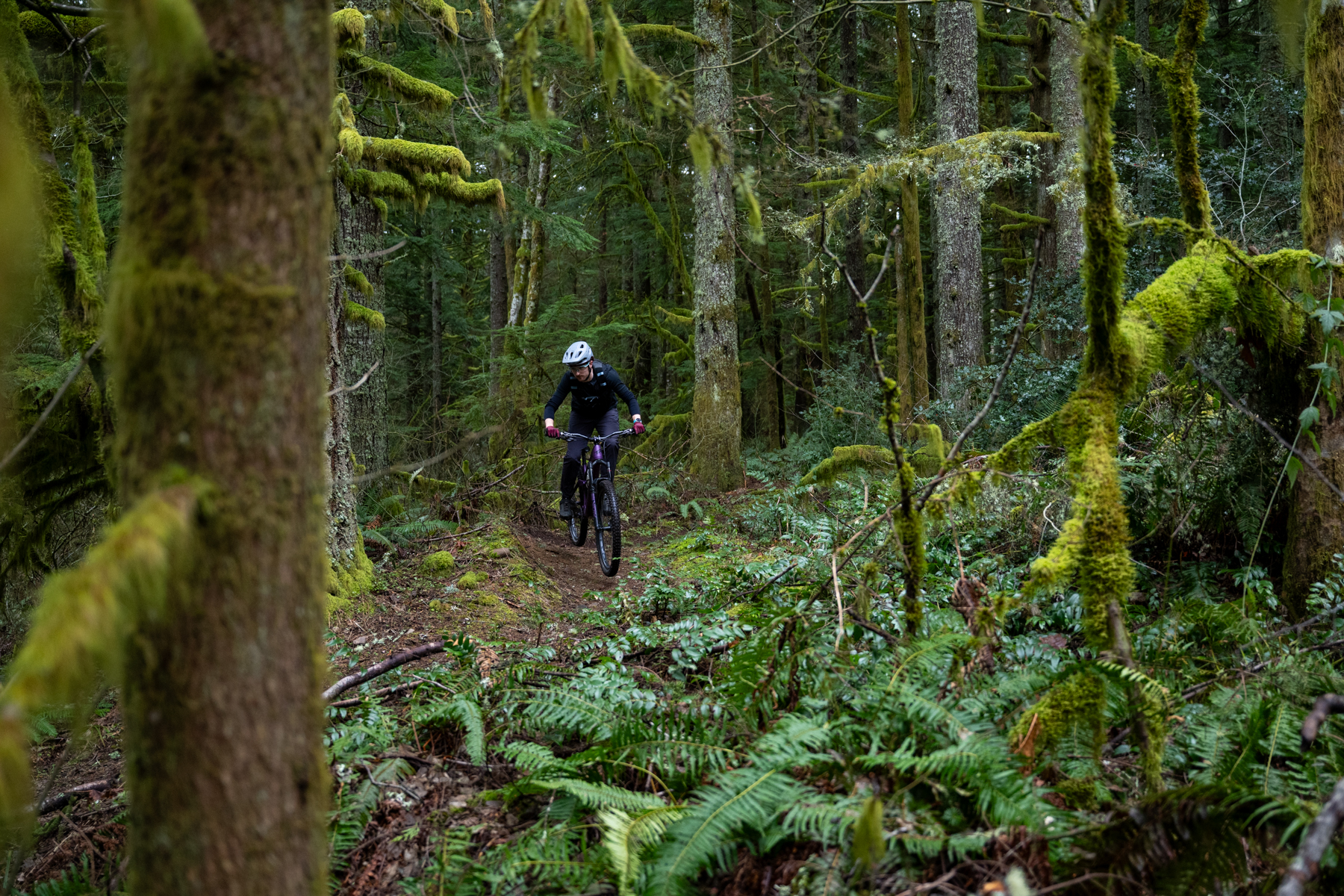
Even while climbing, the difference between the Mara Pro PB and stock Super Deluxe Ultimate was night and day. The much higher levels of compression damping support from the Mara Pro PB had the effect of calming the rear suspension substantially while under power, making the Sentinel feel much more efficient.
David: We’ll get into my thoughts on the Sentinel’s shock tune in the Descending section in just a minute, but I didn’t find the Sentinel to suffer from an undue amount of suspension movement with the stock shock — even with the climb switch off — but the fact that I was running a notably firm spring rate to compensate for the very, very light compression tune undoubtedly helped there. The RockShox Super Deluxe Ultimate shock also has a very effective climb switch (as usual for the Super Deluxe) if you feel the need to use it.
That said, I’m mostly on the same page as Zack re: the Sentinel’s climbing performance. It’s very happy to grind its way up a steep fire road with reasonable efficiency, and while the Sentinel’s seated position is relatively upright for a ~150 mm-travel Trail bike (both in terms of the seat tube angle and the bar position / height I wound up preferring on it), I found the Sentinel to be a pretty good technical climber, too. I tend to find bikes that favor low-ish bar heights and that feature short wheelbases to be easiest to manage in really tight, ledge-y climbing, and while neither of those things applies to the Sentinel, I got along with it quite well on a trip to Tucson, AZ — the land of big, square-edged rocks.
Compared to some shorter, more compact bikes in its travel range, the Sentinel takes slightly more exaggerated movements to loft over bigger obstacles and ledges, but it’s got a big enough sweet spot to make doing so pretty easy — I think its long chainstays both make those larger movements necessary, and make them relatively easy to pull off. Unlike a lot of other bikes with long-ish wheelbases, there’s still a lot of room to get the bashguard up and over things, seemingly due to the Sentinel’s fairly high bottom bracket.
Descending
Zack: I already introduced my gripe with the shock tune, so I’ll go ahead and get its impact on the Sentinel’s descending performance out of the way. On the way down, the stock Super Deluxe Ultimate was again disappointing in its lack of damping. Even with both compression adjustments maxed out, it blew right through the stroke on bigger and square-edged hits before running into the air spring’s progression at the end of the stroke, making the rear end of the bike feel both unsettled and harsh. Sure, it tracked the ground well at slower speeds, but overall it felt mushy — it frankly couldn’t hold a candle to the very capable Lyrik Ultimate fork.

Again, all of that changed once I swapped the shock. The rear suspension gained magnitudes of composure while also becoming more forgiving, thanks to more judicious use of its travel. Even in the 160 mm travel setting afforded by my use of a 65 mm stroke shock (over the stock 60 mm configuration), the Sentinel does not feel like a true Enduro bike — it offers decent stability but still feels fairly responsive, particularly in how the suspension seems to pop off of obstacles. It’s not quite as eager as some other (often shorter and steeper) Trail bikes when it comes to playing around on the trail, but it still feels light when sent airborne.
David: Yup. The Sentinel’s descending performance is, frankly, let down by its bizarrely light compression damping tune. I spent much of my time on the Sentinel with the stock shock, but tried both a Fox Float X Factory with the base aftermarket tune — not the one that Transition chose for Sentinel builds that are so equipped — and then a different RockShox Super Deluxe Ultimate with a much firmer compression tune than stock. The Float X was a step in the right direction, but still lighter than I wanted; the firmed-up Super Deluxe was a massive improvement.
Particularly with the stock shock, I felt like the Sentinel was too eager to blow through the middle part of its travel, particularly when riding choppier sections of trail at speed, and its chassis stability suffered as a result. Running relatively few volume spacers and quite high air pressure / relatively little sag proved to be the best compromise that I could find, but I still wanted more compression damping — especially high-speed. I’d have preferred to be able to run more sag to bring the ride height back down, particularly given the Sentinel’s fairly high bottom bracket, but found that running lower air pressure and using volume spacers to get bottom-out resistance back only exacerbated how quickly the Sentinel moved through the middle part of its travel.
Swapping in a shock with a firmer compression tune was transformative. It’s not quite a perfect A-B test of the shock tune, since the version of the RockShox Super Deluxe with the firmer compression tune was also configured with a 65 mm stroke (vs. 60 mm stock), but I’m confident that the added compression damping made a much bigger difference than the extra 10 mm of rear wheel travel afforded by the longer stroke.

With the stock shock, the rear wheel of the Sentinel felt like it had a tendency to hang up on square-edged hits at speed. I think this was because the bike was using too much of its rear travel too readily, pitching the chassis rearward and forcing me to make a precisely-timed forward weight shift to drive the front end back down. Riding the Sentinel very dynamically and boosting off of obstacles was the most effective strategy I found to avoiding that sensation, but it felt like I needed to deliberately not ask much of the rear suspension when I wanted to push the pace on faster, rougher trails.
But, again, swapping in the second Super Deluxe with the firmer compression tune solved those issues completely — it’s a matter of the shock tune, not anything inherent to the Sentinel frame itself. The rear end of the bike felt far, far more settled and composed, and I was able to ride the Sentinel from a more centered position and let the rear end do more work, instead of feeling like I needed to stay forward on the bike and pick the rear wheel up over things to avoid overwhelming the rear suspension.
With the stock shock, the Sentinel feels very notably lively for a 150 mm-travel bike, but needs a precise touch to ride faster, rougher trails at pace. With the firmed-up shock tune, it’s still a somewhat lively, energetic bike — as Zack said earlier, it feels more like a long-legged Trail bike than a mini-Enduro one — but the Sentinel feels much more well-rounded with a bit more damping from the shock.
I don’t mean to harp on the shock tune too much, but it’s hard to overstate how different the Sentinel felt after the shock swap. The suspension performance changed dramatically; that let me set the suspension up differently, which lowered the dynamic ride height in many situations and, in doing so, improved the Sentinel’s high-speed handling. Even with the revised shock tune, the Sentinel is still a lively bike that favors an active, dynamic riding style over simply trying to bulldoze whatever’s in front of it. That tendency is just tamped down a bit, and the Sentinel feels more composed and more well-rounded for it.
Shock tune aside, there’s a lot to like about the Sentinel as a very versatile longer-travel Trail bike. As ~150 mm-travel Trail bikes go, it skews a little more stable than average, but still manages to be pretty engaging and fun on more mellow, rolling trails — particularly ones where you can carry a bit of speed, helped in no small part by its relatively lively, energetic-feeling suspension.

It’s also a bike that feels quite neutral and adaptable in terms of its preferred body positioning. There’s a big sweet spot to move around on the Sentinel without upsetting its weight distribution too badly, and it’s happy to be ridden from a more traditional, forward stance with more weight over the front wheel, or a more centered upright one.
Zack: The Sentinel brings an interesting combination of fairly stable geometry along with a lively-feeling suspension, and it helps to broaden the bike’s all-rounder appeal. Despite being in the same family as the bigger, beefier ZEB, the RockShox Lyrik Ultimate fork feels stiffer off the top and doesn’t seem to sit in the middle of its stroke quite as much, again helping with the lively feel. So while the Sentinel is not the most engaging at lower speeds, pushing into the bike yields solid energy return and helps keep things fun on flatter sections. When it comes to rumbling through rougher sections, the weight balance allows a nicely centered stance, no doubt thanks to the long rear center matched to the reach of our size Large, even if it doesn’t feel quite as composed as a bigger Enduro bike in how it mutes impacts.
Cornering on the Sentinel is more of a mixed bag. While it turns in fairly quickly for having a slack headtube angle and long stays, it doesn’t feel quite as “locked in” in how it tracks through longer, rougher corners as I might have expected for a bike of its stature. This, along with some of its more spirited handling characteristics, seems to also be down to the one slight outlier in its geometry chart — with a 25 mm bottom bracket drop and estimated 350 mm bottom bracket height in full 29’’ configuration, the Sentinel’s bottom bracket is a bit on the high side as compared to other contemporary Trail and Enduro bikes that seem to be in the range of 30–35 mm bottom bracket drop. I find that higher bottom brackets can make a given bike feel a bit more eager to change direction than a lower one might, but at the cost of stability. Lower bottom brackets tend to lend a greater sense of your weight sitting between the two wheels rather than on top of them.
Frankly, I felt that the Sentinel would benefit from a lower bottom bracket height — given all of the other geometry figures, I couldn’t help but feel that a lower bottom bracket would unlock more composure. Running the mixed wheel setup in Transition’s advised configuration (with the flip chip in the higher position) does lower the bottom bracket slightly, lopping 6 mm off of the estimated bottom bracket height (to 344 mm). That’s closer to my preference, and the handling benefited from the change. As our crew here at Blister has discussed before, longer chainstays help quite a bit in mitigating some of the over-eager tendencies that smaller 27.5’’ wheels can exhibit at times, and the long stays on the Sentinel matched the smaller wheel well. The rear end managed to balance breaking loose at will while still holding a line in rougher terrain.
Even with that change, I still felt like the bottom bracket could be slightly lower. So, I went with the nuclear option: I kept the bike in the lower flip chip setting intended for full 29’’ wheels, but just chucked on a smaller 27.5’’ rear wheel. The result was a lot of fun on the right trails. From the get-go, the lower bottom bracket height created a much more stable and settled feel while cornering and riding rough, steep trails. Like the very low bottom bracket height of the Knolly Fugitive 140 in its Low position, railing corners felt very rewarding.

There were some significant compromises, though. While the bottom bracket height was totally reasonable and didn’t drive any wild uptick in pedal strikes, the head angle was closer to 63° and led to some floppy steering on flatter trails and climbs, and the reach got a bit too short — none of those things being particularly well-suited to a bike of the Sentinel’s intentions. It felt lazier on climbs and at slower speeds, and the more upright seated position was less encouraging of high-output pedaling efforts. Simply put, it didn’t feel like the all-rounder Trail bike that the Sentinel seems to be striving to be.
So where does that leave us? In my view, the Sentinel is a fairly stable and composed descender that still has good pep thanks to the suspension, but with a higher-than-ideal bottom bracket height — particularly in 29’’ mode. While the extra ground clearance that it affords may be useful in some locales (e.g., chunky Southwestern US trails), there are a lot of handling benefits that come with a lower bottom bracket, too. It’s nice to have the ability to run a 27.5’’ rear wheel, and I think my favorite configuration was with mixed wheels in the higher flip chip position.
David: I’m in full agreement with Zack here. In our Pacific Northwest home area, the full 29’’ setup on the Sentinel feels higher than I wanted it to be, with its tendency to stand up out of high-speed corners more quickly than I’d like being the biggest downside. In the less steep, chunkier terrain of Tucson, the chainring clearance afforded by the higher-than-average bottom bracket was a clear asset on the way up, but I still would have preferred a lower BB for cornering reasons on the way back down — particularly in faster, sweeping corners with modest grip available.
The “nuclear option” of running the Sentinel with a 27.5’’ wheel in the low geometry position that Zack described isn’t so far off the deep end as to feel entirely unreasonable, but it made the Sentinel feel more sluggish in its handling and less lively and energetic than I wanted. The Sentinel is more of a well-rounded, longer-travel Trail bike than it is a big, smashy Enduro one, and making it wildly lower and slacker just felt like trying to turn it into something that it isn’t.
Like Zack, I found the officially-recommended mullet configuration (high flip chip setting) to be my Goldilocks middle ground. Transition didn’t try to fully preserve the 29er geometry in the mixed-wheel configuration — the Sentinel is a little slacker and a bit lower in that mode — and that proved to be a middle ground that I liked a lot.
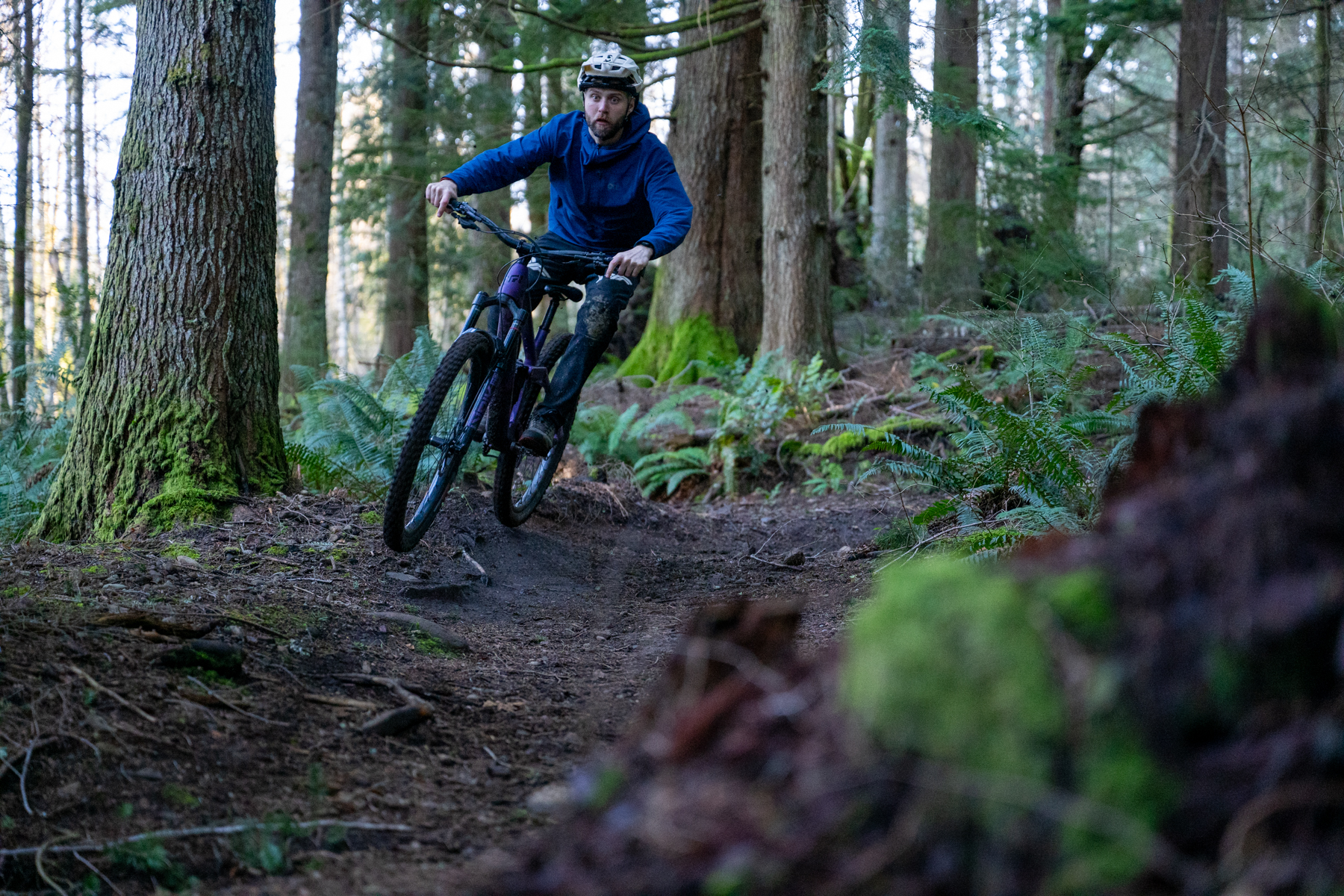
I often find that bikes that can convert between mixed wheel and full 29er setups wind up with chainstays that are shorter than I want them to be in the mixed wheel setup, since most conversion methods wind up shortening them with the smaller rear wheel. Like Zack, I tend to favor moderately long chainstays on mixed-wheel bikes to balance out the handling traits of the smaller rear wheel. The Sentinel’s stays are long enough for that not to be an issue for me, though, and the lower bottom bracket afforded by the mixed-wheel setup goes a long way toward making the Sentinel track more cleanly in fast, high lean angle corners.
The Build
Zack: Our XT build is likely what I would choose if I were buying the Sentinel with my own money, and it leaves relatively little to be desired. Sure, it’s devoid of any electronics, but I’m a big fan of the feel and performance of Shimano’s 12-speed drivetrain, and the XT bits performed well.
The one exception there is the brakes. While the 4-piston Shimano XT stoppers offer a solid amount of power for a bike of the Sentinel’s intentions, I’ve consistently run into consistency issues with the past several sets I’ve tested, manifesting a wandering bite point that makes the lever’s bite point feel unpredictable. This is quite unnerving on steeper trails where braking points are particularly consequential, and it was in those more demanding scenarios on longer, steeper descents where the issue seemed most pronounced.
I won’t rehash my comments from earlier on the rear shock tune, but I strongly feel that Transition should revisit the stock tune on the RockShox Super Deluxe Ultimate rear shock. It simply needs a firmer compression tune. While riders can have the tune changed by their suspension service center of choice for a relatively small fee when the need for a rebuild rolls around, that’s an investment that shouldn’t be needed. Despite my qualms about the rear shock, the Lyrik Ultimate fork was a strong performer — I do like the fine tuning offered by the Grip X2 damper in the Fox 36, but the Lyrik remains an excellent fork for Trail bikes and provides a meaningfully more lively, lightweight feel relative to the burlier Zeb.

The other finishing specs were solid. The DT Swiss M1900 Spline 30 wheels are an unflashy yet dependable choice, and while the Sentinel’s descending capabilities can justify a heavier tire spec, the stock Maxxis tires in their EXO+ casing are generally appropriate for a Trail bike. Transition also deserves credit for maximizing dropper post length on a given size, with our Large sporting a 210 mm OneUp V3 post. Transition’s B.O.O.M. Box downtube storage solution also works well, and though the downtube isn’t quite as cavernous as some other designs, the storage capacity is quite functional.
David: Not much to add. The one big miss in the build spec is the shock tune, with the stock RockShox Super Deluxe simply not generating enough compression damping, even with both adjusters fully closed. Swapping in a Super Deluxe with a firmer compression tune vastly improved the Sentinel’s composure on faster descents, with very few tradeoffs elsewhere. If anything, the firmer compression tune also let me run a bit more rear sag on the Sentinel, which helped with both traction under power when climbing. It also made the Sentinel track more cleanly through higher-lean-angle turns, lowering its dynamic ride height appreciably.
I also experienced the all-too-familiar issues with inconsistent bite point on the Shimano XT brakes on this particular pair. It’s too bad, because I quite like their performance when they’re working consistently, but having spent time on a whole lot of pairs over the years, I’ve had issues with bite point consistency pop up more often than not, and once they have, re-bleeding the brakes is only a temporary fix.
All told, though, the XT build that we tested is a solid value and a pretty nice build overall. I’d just budget in a little extra money to get the shock re-tuned and eventually swap in some more consistent brakes. With those tweaks done, I’d be quite happy with the rest of the spec.

Who’s It For?
Zack: On paper, the Sentinel can look awfully close to an Enduro bike, but it offers a more fleet-footed feel and solid pedaling performance that will appeal to a lot of folks shopping for a generalist all-rounder that is perhaps a touch more stable than average. While the suspension doesn’t hold up as well as an Enduro bike might when truly monster-trucking through rough stuff, it also manages to feel a lot more energetic and poppy than a burlier bike might.
While the rear shock is a bit of a letdown to the rear suspension’s true performance potential, I wouldn’t hesitate to take the stock Sentinel down most trails that I ride on a regular basis. While it certainly is tailored to pedal-accessed riding, it could also hold its own for a day or two in the bike park every year — its versatility should appeal to riders who often ride a wide variety of trails, or who like to regularly explore new areas. The high-ish bottom bracket doesn’t quite mesh with my own personal preferences, but it does have a lot of potential appeal for folks who live in areas with lots of chunky trails where clearance is valuable.
David: Zack and I are on the same page here. The Sentinel is, in many ways, a well-rounded, do-it-all Trail bike that’s a bit quicker handling and not as much of a mini-Enduro sled as its geometry numbers might suggest (or as its predecessor was). It’s hard to make the Sentinel feel truly out of place across a pretty wide range of terrain — it’s a lot more lively and engaging than just about any Enduro bike you can think of on more mellow, rolling terrain, while still being stable and composed enough to handle some very burly descents under a solid rider. The very light compression tune on the rear shock is the one big miss in my book, but it’s a relatively easy fix — especially if you combine re-tuning the shock with a regular service once one becomes due. With that tweak done, it’s a very good all-around longer-travel Trail bike that, as Zack said, is a little more stable than average, while still being a lot of fun when you don’t have a ton of speed and pitch to work with.
Bottom Line
The Sentinel offers a lot to like for folks who value variety in their riding regimen but lean toward more stable-feeling bikes. It’s fairly easy to get along with but can still go hard when called upon, and it feels engaging on both technical trails and more flowy ones, though the high bottom bracket can make it feel a bit less settled in high-speed corners or in very steep terrain than some of its competition. It still offers a compelling mix of traits, and for riders who want a true all-rounder Trail bike, the Sentinel is a solid option.
Deep Dive Comparisons
BLISTER+ members and those who purchase our Digital Access Pass can check out our Deep Dive comparisons linked below. Get our Digital Access Pass to view all our Deep Dives and Flash Reviews, or become a BLISTER+ member today to get access to that and a LOT more, including the best worldwide Outdoor Injury Insurance, exclusive deals and discounts on skis, personalized gear recommendations from us, and much more.

Deep Dive: Transition Sentinel V3
We compare the Transition Sentinel V3 to the Transition Sentinel V2, Knolly Fugitive 140, Santa Cruz Bronson 5, Forbidden Druid V2, Norco Sight, Transition Smuggler, Deviate Highlander II, Kona Process 153, and REEB Steezl.
Blister’s Flash Reviews and Deep Dives are accessible to those who purchase one of our paid subscriptions
To get our comprehensive Deep Dives and our initial, unfiltered reports on new gear, become a member and receive many other services, deals, and discounts.
If you’re already an active member, please log in.
(If you’re already logged in and a member in good standing and seeing this message in error, please refresh this page in your browser.)

Regarding the SD – it looks like the Sentinel comes with the Linear XL air can. Did the second SD you try also have the Linear XL can? I have one of these that I tried on my Heckler SL (C37 shock tune, which is firmer than the retail C34), and with the stock link, it felt kinda uncontrolled. Running more damping on it didn’t feel great. But I tried it again after putting a Cascade link on that bike and bumping the pressure up a lot (~30 psi), and all of the sudden it came alive. At that point it felt very close to my Vivid, but with a bit more pep to it, and more similar/better matched to the Lyrik. I have a hunch that the Linear XL air can is indeed VERY linear, and only works well on bikes with >30% progression. Transitions lately have only been in the mid-20%s, so that could be exacerbating the issue with the light tune.
Good note — I left that part out because it felt like I’d already gone on about the shock a ton, but I tried the second SD with both the standard can that it came with and the XL one from the stock shock.
In short, the standard air can did feel a little more supportive but the increased damping made a way, way bigger difference.
What was the stock SDU compression tune? And what was the firmer tune that felt better?
Thanks!
Any chance you can speak to your settings you landed on for the Mara Pro PB?
I don’t recall my exact settings, but if memory serves I was running 30% sag with one additional larger volume spacer added from the stock setup. Damper settings were rebound nearly open (~2 clicks from open), HSC in the middle of the range, and LSC 1-2 clicks closed from the middle of the range.
Thanks Zach!
I tried running a little more than 30% on my v3 to keep the bb a little lower but was running into some issues bottoming out too easily. Will add a spacer and maybe bump the compression a click or two.
Hey Zack, I’m extremely curious which compression tune ended up being better. I am planning to retune the SDU to a C34 tune and go to 160mm, but I’d love to know what worked for you.
The Super Deluxe with the firmer compression tune was a Super Deluxe C1, so the tune codes aren’t apples to apples with the newer ones. That one had been taken from an L1 compression tune to the firmer L option. I can’t say whether that correlates with the C34 tune given the generational difference in the shocks, but it seems like a good place to start, and you could always go up from there at time of next service.
Thanks Zach, I really appreciate the reply! Based on the Rockshox guide, the compression tunes for the C1 are LC, L1, L, M, and H, in order, so L would be middle of the range I suppose. Trailhead says that the Sentinel stock shock is a C26, and from there it goes C30, C34, C37, C40, C43, so C34 seems like it shouldn’t be excessive. Lots of folks seem more inclined to swap to another shock (often a Vivid) on this bike and be happy, and my hunch is that it has more to do with having an adequate compression tune than the SDU being inadequate for the bike. As you say, I can always retune the compression again later, or go with a different shock if need be.